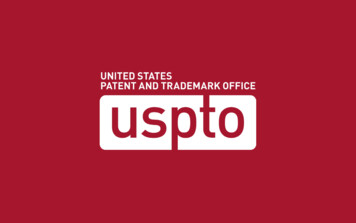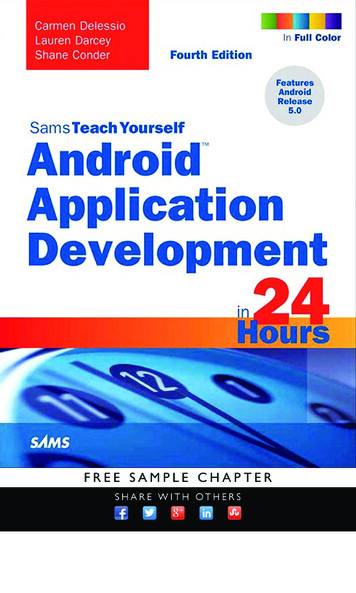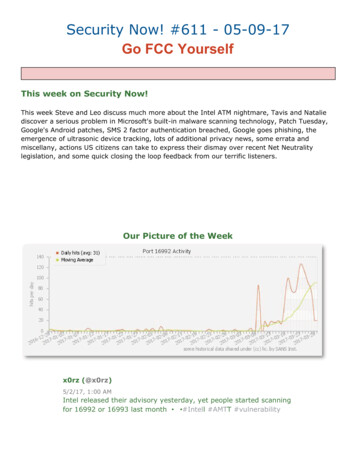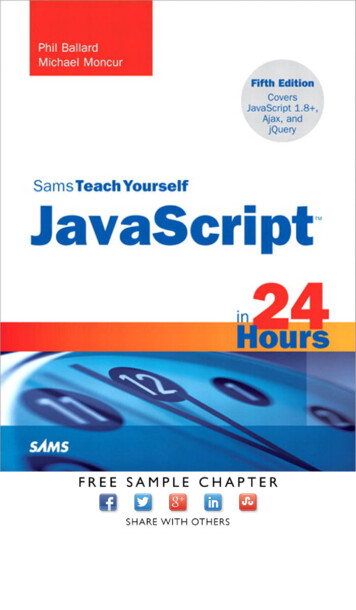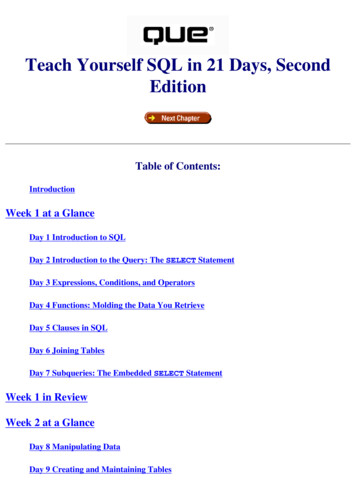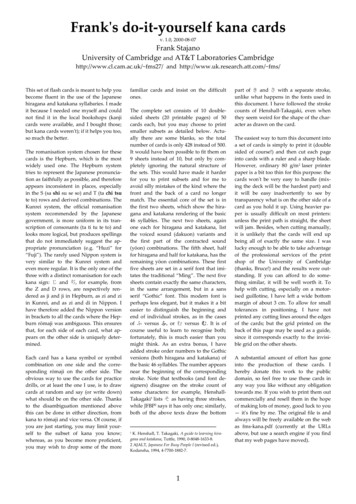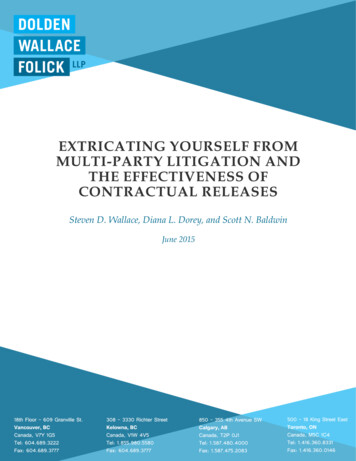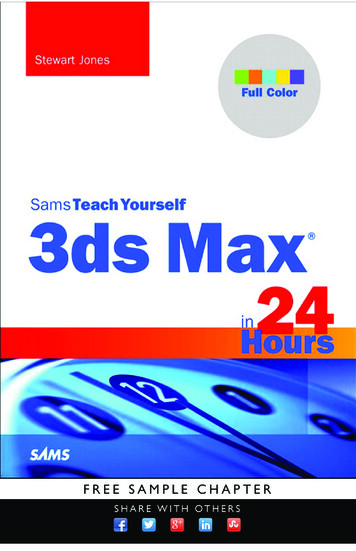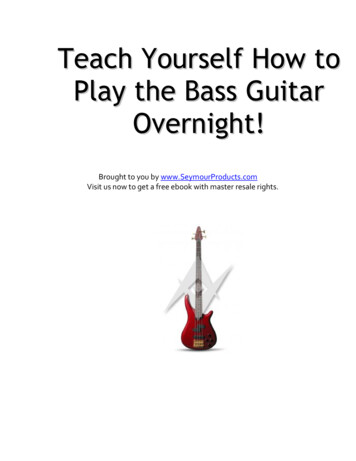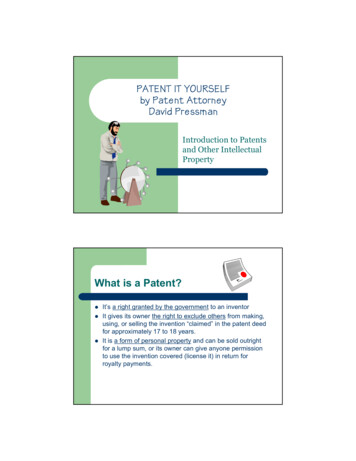
Transcription
PATENT IT YOURSELFby Patent AttorneyDavid PressmanIntroduction to Patentsand Other IntellectualPropertyWhat is a Patent?zzzIt’s a right granted by the government to an inventorIt gives its owner the right to exclude others from making,using, or selling the invention “claimed” in the patent deedfor approximately 17 to 18 years.It is a form of personal property and can be sold outrightfor a lump sum, or its owner can give anyone permissionto use the invention covered (license it) in return forroyalty payments.1
The 3 Types of Patentsz UTILITY¾¾¾PATENTCovers inventions that function in a unique manner toproduce a utilitarian result.New drugs, electronic circuits, software, semiconductormanufacturing process, new bacteria, newly discoveredgenes, new animals, and virtually anything under thesun that can be made by humans.Patent application must consist of detailed descriptiontelling how to make and use the invention, together withclaims that define the invention, drawings of theinvention, formal paperwork, etc.The 3 Types of Patentsz Design¾¾¾PatentCovers the unique, ornamental, or visible shape or design ofa non-natural object.The uniqueness of the shape must be purely ornamental oraesthetic; if it is functional, then only a utility patent isproper. A useful way to distinguish between a design and autility invention is to ask, “Will removing or smoothing outthe novel features substantially impair the function of thedevice?”The design patent application must consist primarily ofdrawings.2
The 3 Types of Patentsz PLANT¾PATENTCovers asexually reproducible plants (through the use ofgraft and cutting), such as flowers.How Long Do Patent Rights Last?zzzUtility and Plant Patents expire 20 years fromthe date of filing.Every patent is guaranteed an in-force periodof at least 17 years.From the date of filing to issuance (termed“pendency period”) the inventor has no rights.3
The Life of an Invention1.2.3.4.5.Invention conceived but Not YetDocumentedInvention Documented but PatentApplication Not Yet Filed.Patent Pending-Patent Application Filed butNot Yet IssuedIn-Force Patent-Patent Issued but Hasn’tYet ExpiredPatent ExpiredPatent FeesAssuming that patent attorneys or agents, andnot including costs of drawings, typing,photocopying, and postage, the only fees onewould have to pay are government fees.The amounts of these fees are listed on the PTOFee Schedule in Appendix 4.The large-entity fees are generally paid bycorporations, while the small-entity fees are paidby independent inventors.4
Patent FeesUtility Patent Application Filing Fee 750/375 Utility Application Issue Fee 1,300/650 Maintenance Fee 1 (3 years) 890/445 Maintenance Fee 2 (7 years) 2,050/1,025 Maintenance Fee 3 (11 years) 3,150/1,575 Patent Fees Design Patent Application Filing Fee 330/165Design Application Issue Fee 470/235No Maintenance Fees for Design PatentsPlant Patent Application Filing Fee 520/260Plant Application Issue Fee 630/315No Maintenance Fees for Plant Patents5
How Patent Rights Can Be LostzzzzzMaintenance fees aren’t paidProved that the patent fails adequately to teach howto make and use the invention, or improperlydescribes the inventionOne or more earlier patents or publications areuncovered which show that the invention of thepatent wasn’t new or wasn’t different enough.Patent owner engages in certain types of illegalconduct.The patent applicant committed fraud on the Patentand Trademark Office by failing to disclose materialinformation.What Cannot Be PatentedzzYou can’t patent any process that can beperformed mentally.Same applies to abstract ideas, inventionsthat aren’t reducible to hardware form, orinventions that don’t involve the manipulationof hardware or symbols to produce a usefulresult.6
Intellectual Propertythe BIG pictureIntellectual Property refers to any product of thehuman mind or intellect, such as an idea,invention, expression, unique name, businessmethod, industrial process, or chemical formulawhich has some value in the marketplace andthat ultimately can be reduced to a tangible form,such as a computer, a chemical, a softwarebased invention, a gadget, a process, etc.Intellectual Propertythe BIG picture¾¾¾Intellectual property law has fallen into several distinctcategories, according to the type of property involved:PATENT LAW deals with the protection of the mental conceptsor creations known as inventions (utility, design, and plant).TRADEMARK LAW deals with the degree to which the ownerof a symbol used in marketing goods or services will beafforded a monopoly over the use of the symbol (Coke).COPYRIGHT LAW grants authors, composers, programmers,artists, and the like the right to prevent others from copying orusing their original expression without permission and torecover damages from those who do.7
Intellectual Propertythe BIG picture¾¾TRADE SECRET LAW deals with the acquisition of offensiverights on private knowledge that gives the owner a competitivebusiness advantage (Coca Cola recipe).UNFAIR COMPETITION LAW affords offensive rights toowners of non-functional mental creations that do not fall withinthe rights offered by the four types of law just discussed(Kodak’s yellow film package, Duracell’s copper-top).TRADEMARKSTMzzA trademark is any word or other symbol that isconsistently attached to, or forms part of, a productto identify and distinguish it from others in themarketplace.A clever trademark can be used with an invention toprovide it with a unique aspect in the marketplaceso that purchasers will tend to buy the trademarkedproduct over a generic one.8
TRADEMARKSTMHow Offensive Rights to Trademarks are Acquireda.b.c.d.e.f.Preserve Your Mark as a Trade Secret Until You Use it.Make Sure the Mark Isn’t Generic or Descriptive.Make Sure Your Mark Isn’t Already in Use.Use or Apply to Register Your Trademark.Use and Register Your Trademark.Use Your Trademark Properly.COPYRIGHT zA copyright is another offensive right given bylaw, this time to an author, artist, composer, orprogrammer, to exclude others from publishingor copying literary, dramatic, musical, artistic, orsoftware works.9
COPYRIGHT Areas where Patent and Copyright Law Overlap:Computer Software – Why patent software opposedto simply registering a copyright on it? 20 years of offensive rights, but2 years and to obtain a patentCopyright compared to Design Patents – if the workis purely artistic, a design patent is improper Design where the shape is inseparable from the objectTrade SecretsIt is any information, design, device, process,composition, technique or formula that is not knowngenerally and that affords its owner a competitivebusiness advantage.Items considered as Trade Secrets:-Chemical Formulas ( paper)-Chemical Recipes(formulas & process)-“Magic-type” Trade Secrets-Manufacturing Process-Business-information Type Trade Secrets10
Relationship of Patents toTrade SecretszzzzIf your invention is maintained as a trade secret andyou put it into commercial use, you must file a patentapplication within one year of the date the inventionwas used commercially.For the first 18 months of the application period, it ispossible to apply for a patent and still maintain theunderlying information as a trade secret.If you don’t file a Nonpublication Request (NPR), yourapplication will be printed verbatim after 18 months andall of your secret “know-how” becomes public.If your patent is refused, the competition will still notknow about your invention and any competitiveadvantage.Advantages ofTrade Secrets Protection¾¾¾¾¾¾The possibility of perpetual protection; beyond thepatent’s 20 years, trade secrets will last indefinitely ifnot discovered.Can be maintained without the cost or effort involvedin patenting.No need to disclose details of your invention to thepublic for Trade Secret Rights.No one can look at your Trade Secret and try todesign around it.Can be established without naming any inventors.Obtained immediately, whereas patents takes acouple of years to obtain.11
Disadvantages ofTrade Secrets Protection¾¾¾They can’t be maintained when the public is able todiscover the information by inspecting, dissecting,or analyzing the product (reverse engineering).Strict precautions must always be taken andcontinually enforced to maintain the confidentialityof the trade secret.More difficult to sue on and enforce on than apatent; trade secrets must be proven to exist to thecourt before the suit may proceed.UNFAIR COMPETITIONzzzThe area of ‘unfair competition’ is the mostdifficult to explain.Can be used to cover such items asadvertising symbols, methods of packaging,slogans, business names, trade dress.When the characteristics of a product orservice aren’t distinctive or defined enough tobe considered a trademark.12
If your Creation Relates to:The functional aspect of any machine, articlecomposition, or process or new use of any of theforegoing-such as circuits, algorithms that affectsome process or hardware, gadgets, businessmethods, apparatus, machinery, tools, devices,implements, chemical compositions, and industrialor other processes or techniques that one coulddiscover from final product, toys, game apparatus,semiconductor devices, scientific apparatus,abrasives, hardware, plumbing, parts, alloys,laminates, protective coatings, drugs, sportinggoods, kitchen implements, locks and safes,timekeeping apparatus, cleaning implements, filtersrefrigeration apparatus, environmental controlapparatus, medical apparatus, new non-humananimals, new bacteria, plant (sexually or asexuallyreproducible), or anything else made by humanswhere the novel aspects have a functional purpose.If your Creation Relates to:Any new design for any tangible thing where thedesign is nonfunctional and is part of and notremovable from the thing, such as a bottle, acomputer case, jewelry, a type of material weave, atire tread design, a building or other structure, anyarticle, item of apparel, furniture, tool, computerscreen icon, etc.Any asexually reproduced plant.Acquire OffensiveRights By:UTILITY PATENTAcquire OffensiveRights By:Design PatentPlant Patent13
If your Creation Relates to:Acquire OffensiveRights By:Any symbol, sign, word, sound, design, device,shape, smell, mark, etc., used as a brand name(trademark), service mark, certification mark, orcollective mark, such as “AjaxTM tools.” (Thesymbol cannot be generic or descriptive – e.g.“electric fork.”)Using it as a trademark with“TM” or “SM” superscript andthen registering it in stateand/or federal trademarkoffices.Any book, poem, speech, recording, computerprogram, work of art (statue, painting, cartoon,label), musical work, dramatic work, pantomime andchoreographic work, photograph, graphic work,motion picture, videotape, map, architecturaldrawing, artistic jewelry, gameboard, gameboardbox and game instructions, etc.Placing a correct copyrightnotice on the work, e.g., “ 1991 M. Smith”; apply forcopyright registration,preferably within threemonths of publication.If your Creation Relates to:Acquire OffensiveRights By:Any information whatever that isn’t generally knownthat will give a business advantage or iscommercially useful, such as formulae, ideas,techniques, know-how, designs, materials,processes, etc.Identifying it as proprietaryinformation or a trade secret,or put it on an inventiondisclosure-type form andlimit its dissemination usingappropriate means.Any distinctive design, slogan, title, shape, color,trade dress, package, business layout, etc.Using it publicly as much aspossible, in advertising, etc.,so as to establish a“secondary meaning” toenable you to win an unfaircompetition lawsuit.14
The Science and Magic ofInventing and DocumentationWhat can small inventor do?FACT:73% of all inventions that have startednew industries have come fromindividual inventors.z “Everything that can be invented hasbeen invented” (U.S. Patent OfficeDirector urging President to abolishthe Office in 1899)z15
InventionIs anything, process, or idea that isn’tgenerally and currently known.z Must have some use or value to society.z Must be generally unknown anywhere in theworld, and it must have been thought up ordiscovered by you or someone else.* This eliminates fantasies and wishes.zInventingzInventing by Problem Recognition and Solution–zRecognizing a problem & fashion a solution.Inventing by Magic (Accident and Flash of Genius)16
Making Ramifications of YourInventionWrite down the problem and solutioninvolved.2. Try to make it cheaper, faster, bigger orsmaller, etc.* Make sure you record in writing anyramifications you do come up with.1.Solving Creativity ProblemszzzzzzFrame It differentlyUse Your Right BrainLet Go of AssumptionsMeditationDreamsComputerize Creating17
Solving Creativity Problems (cont)zzzzzzThe Hot Tub MethodUnstructured FanaticismGroup BrainstormingIncrease Self-Confidence20 QuestionsIdea ToolsContact Other InventorsMinnesota Inventors congresshttp://www.invent1.orgz Patent Café http://www.patentcafe.comz IPChttp://www.heckel.orgz Inventor’s Digest Onlinehttp://www.inventorsdigest.comz18
Beware of the Novice Inventor’s“PGL Documentation19
Documents are Vital to the InventionProcess1.2.3.Good Engineering PracticePsychological StimulusAnalyzation StimulusDocumentation Is Vital to ProveInvention1.2.3.4.5.6.In Case of an InterferenceProof in Case of TheftProof in Case of Confusion of InventorshipAntedate ReferenceSupporting Tax DeductionsAvoidance of Ownership Disputes20
Record the Building and Testing ofYour Invention1.2.Keep Good Records of Building andTesting ActivityKeep Your Building and Testing ActivityConfidentialInventor’s Commandment #2zTo invent successfully, be aware of problemsyou encounter. Also, take the time to studyand investigate the practicality of newphenomena that occur by accident or flash ofinsight. Persevere with any development youbelieve has commercial potential.21
Inventor’s Commandment #3zAfter conceiving of an inventions, youshouldn’t proceed to develop, build, or test it,or reveal it to outsiders, until (1) make a cleardescription of your conception (using ink), (2)sign and date the same, and (3) have thisdocument signed and dated by twotrustworthy people who have “witnessed andunderstood” your creation.Inventor’s Commandment #4z(1) Try to build and test your invention (if atall possible) as soon as you can, (2) keep fulland true written, signed, and dated recordsof all the efforts, correspondence, andreceipts concerning your invention,especially if you build and test it, and (3)have two others sign and date that they have“witnessed and understood” your buildingand testing.22
Recording and DisclosingzzzzzNotebookInvention DisclosureDisclosure Document ProgramProvisional Patent ApplicationPost Office Patent2NotebookzUse a lab notebook–––zProvides evidence if inventorship is questionedShould be permanently bound with numbered pagesDate, sign, and witness oftenUse notebook as technical journal––––Include technical notes, ideas, observationsBe concise, clear, understandableUse technical sketches liberallyWrite in pen, noting mistakes4623
Notebook 2zMake the notebook easy to read––––Use headings: title, purpose, description,conclusions, advantages, prior art referencesAvoid unnecessary, ungrounded opinionsMake references between related entriesAttach large articlesRefer to attachments in printz Label, sign, date, witness attachmentsz47Notebook 3zUse reliable witnesses–––––zShould be impartial and competentShould witness what is recorded, not signatureNotary is unnecessaryEnsure confidentialityUse two witnesses if possibleKeep notebook for proof of invention4824
Invention DisclosurezzUse when notebook is inconvenientIs a complete record of scriptionFeaturesMore formal than a journalSoft copy is insufficient49Disclosure Document ProgramzzzzInstead of witnesses, send Invention Disclosure toPTOMust prepare papers, but no need to use witnessesNot a substitute for a patent application or buildingand testingNot recommended––zCosts moneyWitnesses are equally good or betterBeware of scams5025
Provisional Patent ApplicationzShort version of regular patent application–––zzzzDetailed description of how to make and useinventionDrawings of how to make and use inventionSubstitution for building and testingFile as evidence of invention; file regularpatent application within one yearIs not a regular patent applicationDoes not result in a patentUnread unless invention is challenged51Provisional Patent ApplicationzAdvantages–More timebuilding and testingz study marketz raise moneyz 1 year patentz–––Witnesses notneededSolid proof“Patent pending”zDisadvantages––––––More costMore timeIncompatible withdesign patentsDetails are necessaryRPA must be filedwithin a yearMay encourage apathySource: http://www.bpmlegal.com/provapp.html5226
Provisional Patent Applicationz5 steps in preparing a PPA–––––zPrepare drawingsPrepare detailed description of invention structureand operationPrepare cover letter and feeAttach payment and postcard to PPA packageMail papers to PTOForeign filing––recognized by members of Paris Conventionunrecognized by non-members of ParisConvention53Patentability versusCommercial ViabilityzIs it likely to sell?––zEvaluate for commercial potentialFactors affecting the marketability of yourinventionIs it patentable?–Make a patentability search27
Legal Requirements for a Utility PatentzIs it in a statutory class?–zzzFive classes established by CongressIs it useful?Does it have any novelty?Is it unobvious?Req. #1: The Statutory ClasseszProcesses zMachines zzzConventional ProcessesSoftware ProcessesInternet Business MethodsConventional MachinesSoftware MachinesManufacturesCompositions of MatterNew Uses of Any of the Above28
Req. #2: UtilityzzzzzzzzUnsafe New DrugsWhimsical DevicesInventions Useful Only for Illegal PurposesImmoral InventionsNon-Operable InventionsNuclear WeaponsTheoretical PhenomenaAesthetic PurposeReq. #3: NoveltyzPrior Art What Is Prior Art?Date of Your InventionThe One-Year RuleSpecifics of Prior ArtoooooozPrior Printed Publications AnywhereU.S. Patents Filed by Others Prior to Your Invention’s ConceptionPrior Publicly Available Knowledge or Use of the Invention in the U.S.Your Prior Foreign PatentsPrior U.S. InventorPrior Sale or On-Sale Status in the U.S.Any Physical Difference Will Satisfy Physical DifferencesNew CombinationsNew Use29
Req. #4: UnobviousnesszzzUnobvious to Whom?What Does “Obvious” Mean?Examples: Obvious: Replacing vacuum tube with a transistorUnobvious: Using aspirin as a growth stimulantReq. #4: Unobviousness (cont.)zSecondary Factors in Determining Unobviousness Previous failure of othersSolves an unrecognized problemSolves an insoluble problemCommercial successCrowded artOmission of elementUnsuggested modificationUnappreciated advantageSolves prior inoperabilitySuccessful implementation of ancient idea where others failedSolution of long-felt needContrary to prior art’s teaching30
Req. #4: Unobviousness (cont.)zSecondary Factors in DeterminingUnobviousness of Combination Inventions Synergism (2 2 5)Combination unsuggestedImpossible to combineDifferent combinationPrior-art references would not operate in combinationOver three prior-art references necessary to show your inventionReferences teach away from combiningAwkward, involved combinationReferences from a different fieldPatent Search31
Reasons to Patent SearchzzzzzA small amount of work now may prevent ahuge waste of timeTo give you a Feel for the ArtTo avoid having to draw objects previouslydrawn in other patentsInformation about Operability & DesignEstimate Financial Gain through the failuresof others[Continued]zzzzzzFamiliarize yourself with the prior art, andfocus on the differencesLearn your inventions “Novel” featuresSearches aid in selling a product to skepticalcompaniesTo find out “what you’ve really invented”To make your patent strongerTo get your Patent examined ahead of turn32
When NOT to searchzzYou’re dealing in a new or arcane fieldA previous search has covered a new searchyou might performWays to search for yourselfzzzPTO in Arlington, Virginia (best place)Local Patent and Trademark DepositoryLibraryIf new technology, computer search33
Useful croPatentwww.micropatent.comPatent g someone to searchzzzLay Patent SearchersPatent AgentsPatent Attorneys34
Preparing your SearcherzzzSend a clear and complete description ofyour invention with easily understandabledrawingsBlank out all dates. This makes it difficult forpotential invention thievesIf using a layperson, ask them to sign a nondisclosure agreement formHow to do a search1.2.3.4.Articulate the nature and essence of yourinvention, using as many terms as you canthink ofFind the relevant classifications for yourinventionNote relevant prior art under yourclassificationReview the prior art to see whether isrenders your invention “obvious”35
Finding the proper classificationSearcher’s Tools:z Index to the U.S. Patents Classificationz Manual of Classificationz Classification DefinitionsComputer SearchingzzzNot recommended to replace a manualsearch if trying to patent low-tech devicesMost basic computer search systems don’tshow the drawings of any prior patentsMost computer search systems do not usePTO classification. Instead, it works like asearch engine36
Evaluating a Patent AttorneyzzzzzAll patent agents and attorney’s are listed inAttorneys and Agents Registered to PracticeBefore the U.S. Patent and Trademark Office(A&ARTP)Find one in the Washington area, not localUse personal referrals, if possibleLocal inventors’ organizationAsk about undergrad degree. Applicable?37
PATENT IT YOURSELF by Patent Attorney David Pressman Introduction to Patents and Other Intellectual Property What is a Patent? zIt’s a right granted by the government to an inventor zIt gives its owner the right to exclude others from making, using, or selling the invention “claimed” in the patent deed for approximately 17 to 18 years.File Size: 476KB
